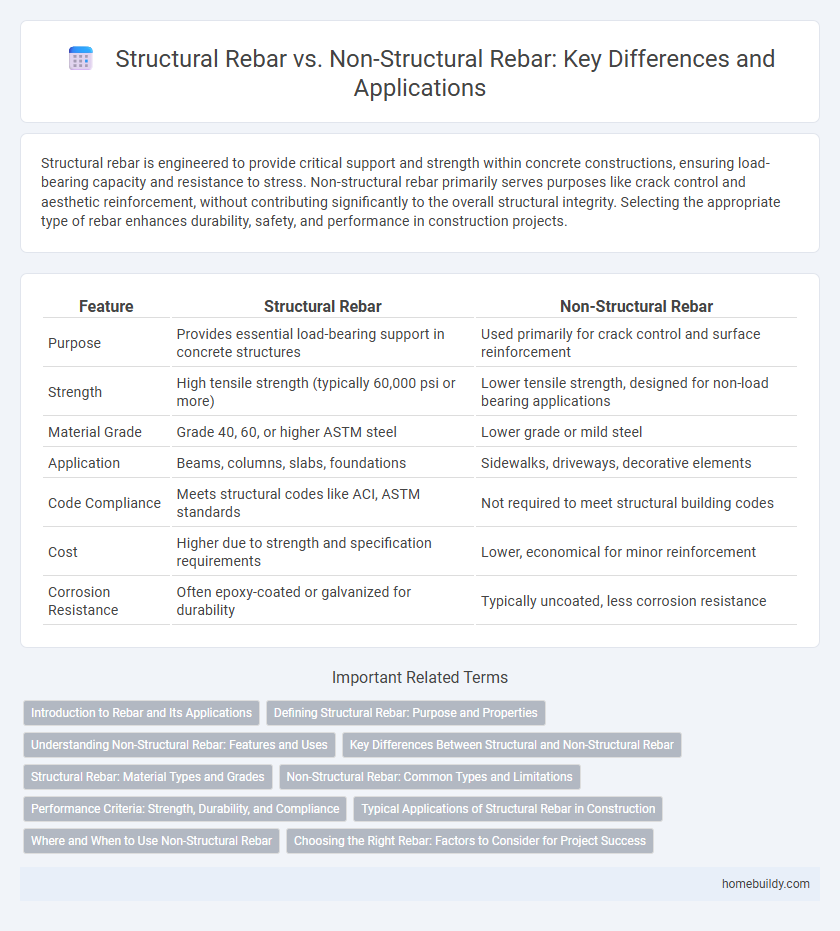Structural rebar is engineered to provide critical support and strength within concrete constructions, ensuring load-bearing capacity and resistance to stress. Non-structural rebar primarily serves purposes like crack control and aesthetic reinforcement, without contributing significantly to the overall structural integrity. Selecting the appropriate type of rebar enhances durability, safety, and performance in construction projects.
Table of Comparison
| Feature | Structural Rebar | Non-Structural Rebar |
|---|---|---|
| Purpose | Provides essential load-bearing support in concrete structures | Used primarily for crack control and surface reinforcement |
| Strength | High tensile strength (typically 60,000 psi or more) | Lower tensile strength, designed for non-load bearing applications |
| Material Grade | Grade 40, 60, or higher ASTM steel | Lower grade or mild steel |
| Application | Beams, columns, slabs, foundations | Sidewalks, driveways, decorative elements |
| Code Compliance | Meets structural codes like ACI, ASTM standards | Not required to meet structural building codes |
| Cost | Higher due to strength and specification requirements | Lower, economical for minor reinforcement |
| Corrosion Resistance | Often epoxy-coated or galvanized for durability | Typically uncoated, less corrosion resistance |
Introduction to Rebar and Its Applications
Structural rebar, made from high-strength steel, is essential for reinforcing concrete in load-bearing elements such as beams, columns, and foundations, providing tensile strength and improving durability. Non-structural rebar, often used in non-load-bearing applications like sidewalks and decorative concrete, primarily controls cracking and shrinkage without bearing significant structural loads. Understanding the distinction between these types ensures proper reinforcement design tailored to specific construction requirements and performance criteria.
Defining Structural Rebar: Purpose and Properties
Structural rebar is designed to reinforce concrete under high stress, providing essential tensile strength that enhances the overall load-bearing capacity of buildings and infrastructure. It is manufactured with specific mechanical properties, such as high yield strength and ductility, to withstand bending, tension, and shear forces during seismic or heavy load conditions. Unlike non-structural rebar, structural rebar meets stringent standards for composition, size, and surface deformations to ensure optimal bonding with concrete and durability over time.
Understanding Non-Structural Rebar: Features and Uses
Non-structural rebar, primarily used for crack control and aesthetic applications, differs from structural rebar by its lower tensile strength and flexible specifications. Common features include corrosion resistance, ease of handling, and suitability for light load-bearing tasks such as driveways, sidewalks, and decorative concrete surfaces. Understanding these uses ensures proper material selection, reducing costs while maintaining concrete durability and preventing surface deterioration.
Key Differences Between Structural and Non-Structural Rebar
Structural rebar is engineered to provide load-bearing support in concrete structures, featuring higher tensile strength and adherence to strict codes like ASTM A615 to ensure safety and durability. Non-structural rebar primarily serves to minimize concrete cracking and improve surface durability, typically having lower tensile strength and used in applications such as sidewalks or decorative concrete. The key differences lie in mechanical properties, regulatory standards, and specific functional roles within construction projects.
Structural Rebar: Material Types and Grades
Structural rebar is primarily made from carbon steel, with grades ranging from Grade 40 to Grade 75, indicating different yield strengths suitable for various load-bearing applications. Stainless steel rebar, including types 304 and 316, offers enhanced corrosion resistance for critical structural elements exposed to harsh environments. High-strength rebar variants often conform to ASTM standards such as ASTM A615 and ASTM A706, ensuring consistent mechanical properties and reliable performance in reinforced concrete structures.
Non-Structural Rebar: Common Types and Limitations
Non-structural rebar commonly includes materials such as welded wire mesh, fiberglass rebar, and plastic-coated steel rebar, which offer corrosion resistance and ease of handling for applications like sidewalks, driveways, and decorative concrete. These types do not provide the same load-bearing capacity as structural rebar and are unsuitable for supporting significant structural loads or seismic activity. Limitations include reduced tensile strength, lower bond performance with concrete, and restrictions in critical structural elements where high durability and strength are required.
Performance Criteria: Strength, Durability, and Compliance
Structural rebar is engineered to meet rigorous performance criteria, offering high tensile strength, superior durability under heavy loads, and strict compliance with building codes to ensure safety and stability in construction. Non-structural rebar typically exhibits lower strength and durability standards, suitable for applications where reinforcing concrete against minor stresses is sufficient without the need for adherence to stringent regulatory requirements. Evaluating rebar selection based on strength, durability, and compliance is critical to optimize structural integrity and longevity in infrastructure projects.
Typical Applications of Structural Rebar in Construction
Structural rebar is primarily used in reinforced concrete construction to enhance the tensile strength of foundations, beams, columns, and slabs. Typical applications include high-rise buildings, bridges, and infrastructure projects where load-bearing capacity and seismic resistance are critical. Its high-grade steel composition and precise placement ensure structural integrity and durability under heavy loads and dynamic conditions.
Where and When to Use Non-Structural Rebar
Non-structural rebar is primarily used in applications where tensile strength is not critical, such as in decorative concrete, sidewalks, or paving slabs. It serves to control shrinkage cracks and improve surface durability without bearing significant loads. Use non-structural rebar when the concrete element is not part of the load-bearing framework but requires reinforcement to prevent cracking or surface wear.
Choosing the Right Rebar: Factors to Consider for Project Success
Selecting the appropriate rebar type hinges on understanding the structural demands and load-bearing requirements of the project, with structural rebar designed to reinforce concrete in load-critical applications while non-structural rebar is suited for decorative or non-load-bearing purposes. Consider factors such as tensile strength, corrosion resistance, project specifications, and environmental exposure to ensure durability and safety. Proper selection directly influences the stability, longevity, and cost-effectiveness of construction outcomes.
Structural Rebar vs Non-Structural Rebar Infographic

 homebuildy.com
homebuildy.com